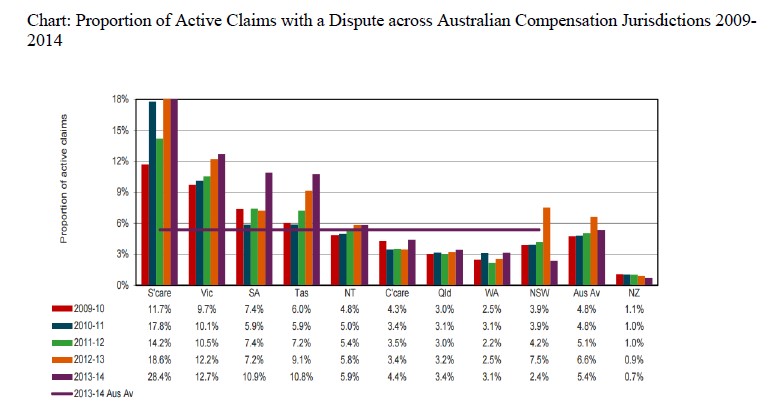Does WorkSafe have a problem?
Blog - Does WorkSafe have a problem?
Dr Mary Wyatt | Published: September 27, 2016

Does WorkSafe have a problem?
Today Gabrielle has written about the Victorian Ombudsman's report into management of workers compensation claims in Victoria, published September 2016.
The report outlines the experiences of around 65 claimants under the workers compensation scheme in Victoria, and the difficulties they faced. The report also takes into account views of scheme participants, many who came forward to express their concerns about how the scheme operates.
WorkSafe's response is published on page 164 of the detailed and concerning report.
To me WorkSafe’s response is the most deeply concerning aspect of the report.
Claire Amies, WorkSafe CEO, responds by stating the Ombudsman's report substantially overreaches based on the evidence considered in the course of the investigation.
While WorkSafe accepts the recommendations made to it by the Ombudsman, the thrust of WorkSafe’s response is that the job they are doing is just fine at the moment: yes, improvements can be made but we’ve got the general thrust right.
In more detail:
WorkSafe’s response touts overall injured worker satisfaction with claims agents increasing from 84% in 2014 to 86% in 2015. This is not a relevant statistic in the circumstances.
As stated by WorkSafe, 20% of claims result in 90% of scheme costs. These are obviously the long-term and more complex cases.
Most of the 80%, those with a short-term interaction with the scheme, are likely to be satisfied. It is the satisfaction of the remaining 20% long-term and complex cases which need to be evaluated if one is to use a statistic such as satisfaction levels to counter the Ombudsman's report. This evaluation has not been offered in WorkSafe’s response.
The cases discussed in the Ombudsman's report are only a fraction of the injured workers who face significant difficulties in dealing with the scheme. Really, what proportion of people do you think take the time and energy to pursue a matter by reporting it to the Ombudsman? Only a small fraction will take up this option, most people simply walk away.
I know, I deal with them.
I try and approach situations recognising there is generally two sides to a story. But I've dealt with cases where I have looked in detail at all the issues, all the paperwork, including letters written by claims agents, and conclude the process has been rigged.
Here's an example.
As a treating specialist seeing a patient with shoulder impingement, I've concluded the injury was work-related. The IME orthopaedic specialist said the injury was work-related. But a small section of a circumstances investigation said the job was not heavy, and on that basis the claim was rejected. No matter that the weight of the items handled was irrelevant, the problem related to the repetitive nature of the job in an awkward position.
She was a good employee who had been with the company for just under 10 years. The whole situation became overwhelming for her, needing to deal with complex letters from insurers, proceeding to conciliation, dealing with her shoulder pain, all the while feeling she was fighting both her employer and the insurer. She walked away from the claim.
The Ombudsman’s report doesn't simply rely on investigating complaints made by workers. People worried about the scheme have come forward. This does not seem to rate in WorkSafe's response.
As doctors, we deal with the fallout of poor decision-making on a regular basis. It's not simply claim rejections and claim terminations, it's the more regular decision-making that goes on, will this treatment get covered, how long will it take for a decision about surgery to be made? And patients frustrations with the lack of follow-through, no response to a phone call, no follow-up on a rehabilitation assessment.
The AMA came forward about these issues. The Senior Conciliation Officer (the manager of the dispute resolution system in Victoria) came forward. In clear terms the Senior Conciliation Officer outlined his endeavours at dealing with WorkSafe to reduce the level of disputes, and WorkSafe’s lack of response to his endeavours. A previous Senior Conciliation Officer also provided input on the difficulties. The AMA have tried for years to provide WorkSafe with feedback about system deficiencies. Ex claims officers have also come forward. (We agree with the Ombudsman that there are many claims officers who do the right thing). It is clear from some internal emails even current staff are expressing concerns about a senior manager seemingly wedded to an entrenched view of 'terminating'.
WorkSafe's response suggests the correctness of decisions made by claims agents is subject to review and scrutiny through several mechanisms. There is an internal review process, which seems to be put forward as a safeguard.
However in the case I've cited above, a family member of the claimant had worked with workers compensation systems. That person requested a review of the claim rejection decision, this made no difference. Discussions were held up to senior management level about the case, these made no difference. As the review points out, internal reviews are still influenced by performance indicators and have been perfunctory in the cases reviewed, and in cases I’ve been involved with.
WorkSafe disputes rates are the highest in the country (other than Seacare, which is a very different scheme, all workers need to be able to return to their full job).. And have increased year-on-year over the last five years. The chart below is from the Safe Work Comparative Performance Monitoring report, which compares jurisdictions. Victoria has the highest rate of disputes in the mainstream schemes.
The chart shows the percentage of claims where there is a dispute. This has been rising every year for the last five years, and is now just under 13% of claims.

Lastly, WorkSafe talks about change, however some of the initiatives being talked about have been discussed for decades. Conciliators suggested sharing IME reports with treating doctors and claimants when the conciliation service was first set up in the early 2000s. It took 20 years of discussions to have WorkSafe agree to fund (a limited number of) general practitioner phone discussions about return to work.
The scheme in Victoria is heavily reliant on claim terminations at the 130 week mark. As a consequence I see poor quality approaches to rehabilitation, particularly where workers need retraining and a long-term change in career. That means less opportunity for re-engagement in the workforce, reliance on terminating payments at the 130 week mark, and legal involvement to settle claims through common law.
Helping people back to work can be time-consuming and complex. It relies on an underlying philosophy of enabling the worker and the employer.
This is not compatible with a scheme driven by significant incentives that are in place to reject and terminate claims.
Does WorkSafe have a problem?
To really change, we need to believe that change is needed.
WorkSafe has for many years resisted external pressures for change. WorkSafe's response to the Ombudsman's report suggests that once again this will be WorkSafe's approach.
Whether WorkSafe responds to the report as though it DOES have a problem seems to depend on how much pressure is applied for change.
Is there political will to push for a fairer and more transparent scheme? How much will scheme participants push for change? Will this be another report that is left to linger until the next damning review?
Or can we imagine that this report will prompt the WorkSafe Board to consider they need to better understand how complex cases are managed within the scheme, and how to better assist that group of claimants to re-enter the workforce and to lead healthier lives as a consequence.
To really change, we need to believe that change is needed.
To really change, we need to believe that change is needed.

